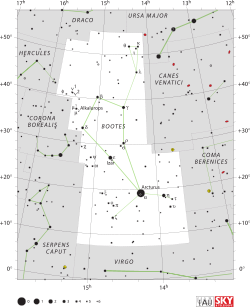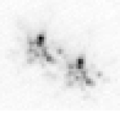Zeta Boötis
| Observation data Epoch J2000 Equinox J2000 | |
|---|---|
| Constellation | Boötes |
| Right ascension | 14h 41m 08.95158s[1] |
| Declination | +13° 43′ 41.8967″[1] |
| Apparent magnitude (V) | 3.78[2] (4.43[3]/4.83[4]) |
| Characteristics | |
| Spectral type | A2III / A2III[5] |
| U−B color index | +0.05[2] |
| B−V color index | +0.05[2] |
| Astrometry | |
| Radial velocity (Rv) | -5.5[6] km/s |
| Proper motion (μ) | RA: +51.95[1] mas/yr Dec.: -11.08[1] mas/yr |
| Parallax (π) | 18.07 ± 1.24 mas[1] |
| Distance | 180 ± 10 ly (55 ± 4 pc) |
| Orbit[7] | |
| Companion | CCDM 14411+1344 B |
| Period (P) | 45,460 ± 62 days |
| Semi-major axis (a) | 2.3 ± 1.7″ |
| Eccentricity (e) | 0.9977 ± 0.0034 |
| Inclination (i) | 102.3 ± 9.2° |
| Longitude of the node (Ω) | 8.2 ± 2.6° |
| Periastron epoch (T) | JD 2460183.5 ± 57 |
| Argument of periastron (ω) (secondary) | 262.9 ± 5.9° |
| Other designations | |
| Database references | |
| SIMBAD | data |
Zeta Boötis (ζ Boo, ζ Boötis) is a binary star system in the constellation of Boötes that consists of two giant stars with matching stellar classifications of A2III.[5] They have the Flamsteed designation 30 Boötis. This system is approximately 180 light years[1] from Earth and has a combined apparent magnitude of +3.78.[2] The individual magnitudes differ slightly, with component A having a magnitude of 4.43[3] and component B at the slightly dimmer magnitude 4.83.[4]
The binary nature of this system has been tracked since 1796. They complete an orbit roughly every 45,460 days, or 124.46 years. The next close approach will occur during August 2023. The orbit of this pair has a very high eccentricity of 0.9977, bringing the stars within 0.3 AU at their closest approach.[7]
-
Zeta Bootis imaged with the Nordic Optical Telescope on 13 May 2000 using the lucky imaging method. (The Airy discs around the stars is diffraction from the 2.56m telescope aperture.)
-
Typical short-exposure image of a binary star, as seen using speckle imaging through the Earth's atmosphere.
References
- ^ a b c d e f van Leeuwen, F. (November 2007), "Validation of the new Hipparcos reduction", Astronomy and Astrophysics, 474 (2): 653–664, arXiv:0708.1752, Bibcode:2007A&A...474..653V, doi:10.1051/0004-6361:20078357
- ^ a b c d Nicolet, B. (1978), "Photoelectric photometric Catalogue of homogeneous measurements in the UBV System", Astronomy and Astrophysics Supplement Series, 34: 1–49, Bibcode:1978A&AS...34....1N
- ^ a b c "HR 5478 -- Star in double system", SIMBAD, Centre de Données astronomiques de Strasbourg, retrieved 2011-12-18
- ^ a b c "HR 5477 -- Star in double system", SIMBAD, Centre de Données astronomiques de Strasbourg, retrieved 2011-12-18
- ^ a b Edwards, T. W. (April 1976), "MK classification for visual binary components", Astronomical Journal, 81: 245–249, Bibcode:1976AJ.....81..245E, doi:10.1086/111879
- ^ Evans, D. S., "The Revision of the General Catalogue of Radial Velocities", in Batten, Alan Henry; Heard, John Frederick (eds.), Determination of Radial Velocities and their Applications, Proceedings from IAU Symposium no. 30 held at the University of Toronto 20-24 June, 1966, Academic Press, London, p. 57, Bibcode:1967IAUS...30...57E
- ^ a b Muterspaugh, Matthew W.; et al. (December 2010), "The Phases Differential Astrometry Data Archive. II. Updated Binary Star Orbits and a Long Period Eclipsing Binary", The Astronomical Journal, 140 (6): 1623–1630, arXiv:1010.4043, Bibcode:2010AJ....140.1623M, doi:10.1088/0004-6256/140/6/1623
- ^ "CCDM J14411+1344AB -- Double or multiple star", SIMBAD, Centre de Données astronomiques de Strasbourg, retrieved 2011-12-18
External links
- Kaler, James B., "ZETA BOO (Zeta Bootis)", Stars, University of Illinois, retrieved 2011-12-18
- HR 5477
- Image Zeta Boötis
- CCDM J14411+1344



